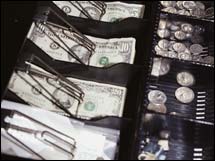Spending growth weakest in 6 monthsSolid income gain isn't enough to keep consumers spending as increase smallest since September.NEW YORK (CNNMoney.com) -- Consumer spending grew at the weakest pace in six months in March, despite solid income growth and good news on a key inflation reading in the government's latest measure of the U.S. economy. Spending by consumers rose just 0.3 percent in March, the Commerce Department reported Monday, down from the revised 0.7 percent rise in February. Economists surveyed by Briefing.com had forecast a 0.5 percent rise in spending. It was the slowest growth in spending since September and followed three straight months with increases of of 0.6 percent or better.
"I don't know if the consumers are getting tuckered out. I think a sharp runup in gasoline prices left them with less money to spend on everything else," said Mark Vitner, senior economist with Wachovia. The weak spending came even as the report showed individual incomes jumped 0.7 percent in March, the same increase as in February, which was revised higher Monday from the original report that showed a 0.6 percent gain. Economists also were forecasting a 0.5 percent rise in that measure. The modest gain in spending was even worse than it first appears, however, since it was driven by increases in the prices of good being purchased, primarily gasoline. When adjusted for inflation, spending actually slipped 0.2 percent, the first decline in real spending since August and the biggest drop by that measure since September 2005, in the wake of Hurricane Katrina, when gasoline prices hit a record high. Still, several economists said they weren't particularly worried about the weak spending number in the report, even though spending by consumers accounts for about 70 percent of the U.S. economy and was one of the only bright spots in an otherwise disappointing gross domestic product report on Friday that showed the weakest economic growth in four years. "It's a weak month at the end of a strong quarter," said economist Robert Brusca of FAO Economics. "It's far too early to start extrapolating economic weakness or a slowdown. As long as we're seeing this kind of income growth, consumers will have a lot of fuel there." Overall, the spending report's measure of prices paid by consumers rose 0.4 percent last month, the same increase as in February. The jump in March put prices up 2.4 percent over the last 12 months, up from the 2.3 percent 12-month gain in February. But the report also had some good news on the inflation. It includes a key inflation measure known as the core PCE price deflator, which measures the prices paid by individuals for goods other than food and energy. That showed no increase in prices in March. The flat reading on core prices in March left that reading up 2.1 percent over the last 12 months, compared to a 2.4 percent rise over the previous 12 months in the February report. The Federal Reserve, which closely watches this reading, is widely believed to want to see the core PCE reading come in at an annual increase of between 1 and 2 percent. Consumers once again spent more than they earned, resulting in a negative savings rate for the 24th straight month. But because incomes grew faster than spending, the negative savings rate edged down to 0.8 percent from 1.2 percent, meaning consumers spent $100.80 for every $100 of after-tax income in March, down from $101.20 in February. |
Sponsors
|



